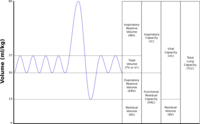
Photo from wikipedia
Objective To compare the six-minute walk test and the Modified Bruce treadmill test in paediatric patients with severe burns. Subjects A total of 67 children, aged 7–17 years, with severe… Click to show full abstract
Objective To compare the six-minute walk test and the Modified Bruce treadmill test in paediatric patients with severe burns. Subjects A total of 67 children, aged 7–17 years, with severe burns. Methods Participants were assigned to perform the six-minute walk test and the Modified Bruce treadmill test in randomized order on discharge from acute burn care. Primary outcome measure was heart rate. Secondary outcome measures were distance walked, Borg’s CR-10 rate of perceived exertion, and maximal oxygen uptake (VO2). Results A total of 67 participants were enrolled. Thirty-eight patients completed both tests. The mean six-minute walk test maximum heart rate was 135 ± 19 bpm (range 97–180 bpm) and the mean Modified Bruce treadmill test maximum heart rate was 148 ± 24 bpm (range 100–197 bpm; p ≤ 0.05), with a weak positive correlation of R² = 0.14. The mean six-minute walk test maximum distance was 294 ± 124 m (range 55 to 522 m) while the mean Modified Bruce treadmill test maximum distance was 439 ± 181 m (range 53 to 976 m; p ≤ 0.05), with no correlation of R² = 0.006. The mean RPE CR-10 score for the six-minute walk test was 3 ± 2.5 (range 0–10) vs a mean RPE CR-10 score of 10 ± 0 for the Modified Bruce treadmill test. Conclusion The Modified Bruce treadmill test challenges the cardiorespiratory system significantly more than the six-minute walk test, as reflected by maximum heart rate measurements, and the perception of effort (i.e. rate of perceived exertion) by the patient. When possible, the Modified Bruce treadmill test should be used to assess cardiovascular functional capacity. However, the six-minute walk test may be more clinically feasible for use with paediatric patients with burns, and provides information about submaximal functional exercise capacity. LAY ABSTRACT Children with severe burns benefit from an implemented outpatient exercise rehabilitation programme. Before prescribing an aerobic exercise programme, patients should be tested in objective manner. Two common tests for these purposes are the six-minute walk test and the Modified Bruce Treadmill test. These tests have been used for measurement of the cardiopulmonary function in this population. The aim of this study was to compare these tests and the level of agreement of their responses. A total of 67 children with major burns participated in the study. Of these, 38 children completed both tests after they were treated in the acute care unit. This study showed that the treadmill test is not in agreement with the six-minute walk test in terms of heart rate. The results suggest the treadmill test should be used to assess cardiovascular functional capacity. However, the six-minute walk test may be more clinically feasible and provides information about submaximal functional exercise capacity.
Journal Title: Journal of Rehabilitation Medicine
Year Published: 2022
Link to full text (if available)
Share on Social Media: Sign Up to like & get
recommendations!